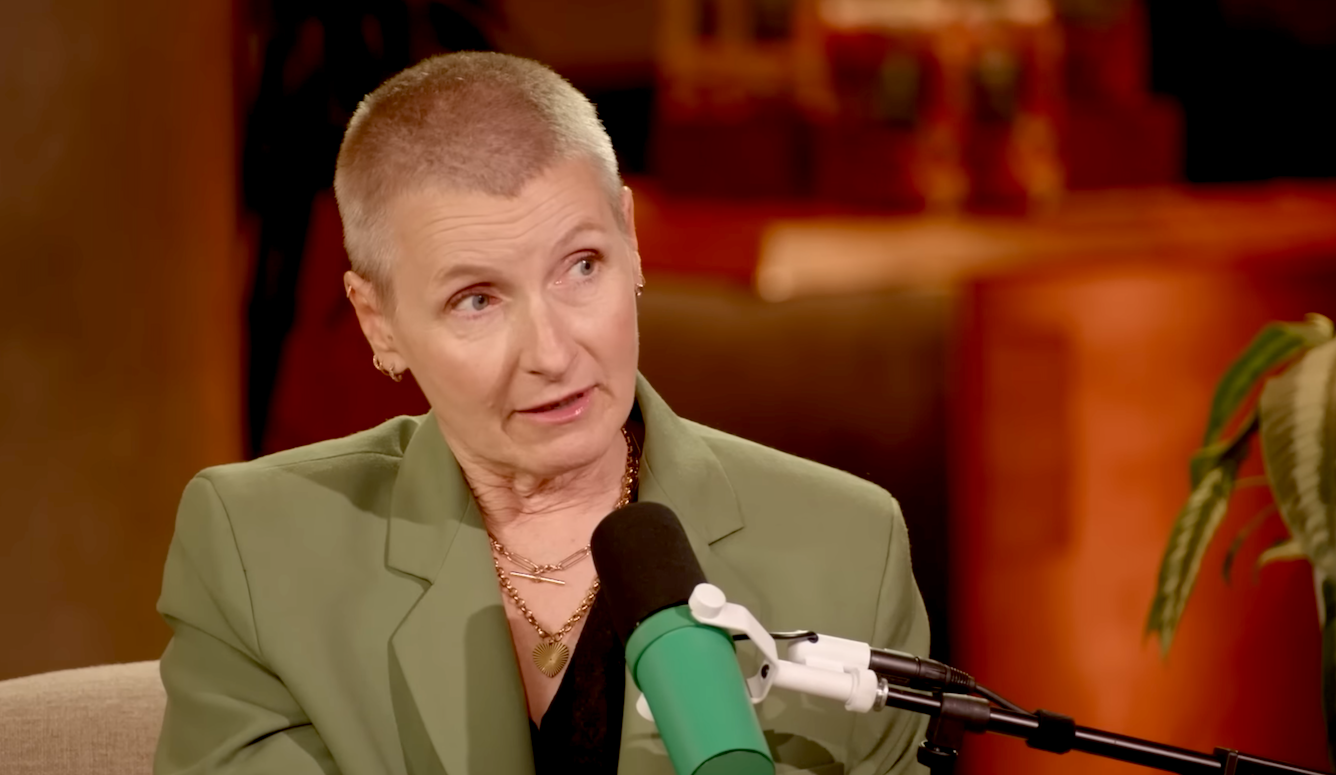Sport
Ignoring Biological Reality Puts Female Hockey Players at Risk
A frightening injury at an NHL-sponsored transgender tournament in Wisconsin reminds us why women’s leagues should remain sex-protected spaces.

On November 22nd, the NHL made headlines when it tweeted that “Trans women are women. Trans men are men. Nonbinary identity is real.” Predictably, this declaration was widely praised by progressives and just as widely mocked by conservatives. And yet, amid all this culture-war sound and fury, there was little news to be had about the event that had precipitated the league’s controversial gender diktat in the first place: an NHL-supported and -sponsored “All-Trans Draft Tournament” held in Middleton, WI—reportedly the first tournament of its kind in the history of hockey.
We had our first ever All-Trans Draft Tournament this weekend. It was amazing. The hockey was fantastic, and the teams all well matched. The arena was just buzzing with trans joy for two solid days.
— Team Trans Ice Hockey (@teamtranshockey) November 21, 2022
Aside from a tweet containing four photos of the November 19th–20th event, the NHL provided no substantive information about how the tournament unfolded. Nor did media outlets such as Hockey News, whose reporting consisted instead of cheery tournament summaries (“The arena was just buzzing with trans joy for two solid days”) sourced to the organizers’ social media accounts. Vice sent a five-person film crew to cover the tournament, including two cameramen, but so far hasn’t reported anything on what that unit filmed. So as far as I know, in fact, I’m the first person to publicly report the events described below.
The NHL is proud to support this past weekend's Team Trans Draft Tournament in Middleton, Wisconsin. This was the first tournament comprised entirely of transgender and nonbinary players, with around 80 folks participating! #HockeyIsForEveryone #NHLPride pic.twitter.com/OfEoAVXtH5
— NHL (@NHL) November 22, 2022
The All-Trans Draft Tournament was organized under the auspices of Team Trans, a Massachusetts-based transgender hockey club that the NHL has been promoting and financing as part of its “Accelerating Diversity & Inclusion” mission. Last year, in a typically upbeat dispatch, NHL.com staff writer Amalie Benjamin reported that Team Trans allows trans hockey players “to be themselves. To open doors. To represent.”
Max Domi, Mark Borowiecki and several others are wishing @teamtranshockey and @MadGayHockey the best of luck in their 2021 Team Trans Friendship Series, which starts this afternoon!
— NHL Public Relations (@PR_NHL) November 20, 2021
Tap here for more details: https://t.co/gyvN65Cdgv pic.twitter.com/N9lHKNIsKq
In this regard, the All-Trans Draft Tournament seems to have been a success: Video from the event venue, Capitol Ice Arena, shows the participants—a mix of trans men and trans women playing side by side—having a great time. The ambience seemed particularly friendly in the opening round-robin phase, during which the bigger and better players appeared to play at reduced intensity in order to keep things competitive. In the entire video archive of the tournament, there’s no fighting to be seen, nor even much in the way of deliberately rough play (which is more than I can say for most of the Canadian hockey tournaments I’ve experienced as either participant or parent). The tournament had been timed to coincide with Trans Day of Remembrance. And at one point, members of all the teams had a group hug and recognized the victims of the previous day’s fatal LGBT nightclub shooting in Colorado Springs.
As most youth coaches and parents can attest, there’s been a growing emphasis on LGBT inclusion within hockey culture for a while now. And by this point, I don’t know anyone involved with the sport who’d dispute the message—attributed to Team Trans by one of Benjamin’s interviewees—“that you belong, no matter who you are, no matter what your gender is.” But as in many other sports, hard questions arise when it comes to the interplay of biological sex, gender identity, and protected female leagues and spaces. Specifically: Should naturally bigger, stronger, faster biological males who self-identify as girls or women be permitted to compete in leagues and tournaments with (on average) smaller, weaker, slower biological females?
The reason why the gender slogans tweeted by the NHL attracted so much controversy is that the league now seems to be answering that last question in the affirmative: That “Trans women are women” post came in direct response to someone who’d asked, “So, men playing on [women’s] team[s]?” Given the NHL’s newly announced position on this subject, one might have expected league officials to demonstrate at least a passing interest in the outcome of the All-Trans Draft Tournament—an event that offered a case study in regard to the rejection of biological sex as a criterion for assessing eligibility.
Trans women are women. Trans men are men. Nonbinary identity is real.
— NHL (@NHL) November 22, 2022
At ordinary hockey tournaments, teams register and compete as collective units—typically representing their school, neighbourhood, city, or region. “Draft” tournaments are different: Players register individually and get assigned to tournament teams through some formal, informal, or even random process. I have no idea what selection method was used at the All-Trans Draft Tournament, where the roughly 80 players were allocated to six teams designated as Black, White, Purple, Blue, Yellow, and Pink. But however it was done, the results were lopsided: A single team, Pink, ended up stacked with physically imposing biological men (i.e., trans women). And by no coincidence, that team also went on to become tournament champion.
This awkward result may help explain why no one seemed anxious to publicize event details once the tournament was over. Team Pink’s victory over Black in the finals—which I was able to watch on video, along with all the other games—was an embarrassing 7–1 rout. According to one rink-side source who attended the tournament, Team Pink players even called a meeting during the second period in order to discuss whether it would be best to end the game prematurely. (Some of their deliberations are audible on the video I viewed.) Two players floated the idea of simply announcing that the tournament was over and that “everyone” had won.
As the main point of contact between TT and the NHL, I can confirm they knew how shit the responses to their support would be. They chose to post anyway 🏳️⚧️🏳️⚧️ #teamtrans #queerhockey https://t.co/yoipAw2hzY
— Mason LeFebvre (he/him/his) (@frozengoalie) November 23, 2022
“There [was] just an enormous difference in size between the two teams—height, weight, shoulder width, muscles—the differences were plain to even a child,” is how one rink-side observer described the finals to me. On video, a quartet of large Team Pink players stood out: #1, #9, #42, and #90. Each of these she/her biological men—at least one of whom played Division I college hockey on a men’s team before transitioning—appeared head and shoulders taller than most of Team Black (whose 12-player roster contained only two she/hers). And this group didn’t even include #29, a speedy Team Pink she/her, and self-described male-to-female trans woman, who consistently skated circles around the opposition, and who ended up netting two hat tricks in the space of four games during the tournament.
(Print copies of the team rosters were available at the arena, but the contents haven’t, to my knowledge, been published electronically. I’ve decided not to indicate the names of individual players, except in such cases where players have gone public on social media. Instead, I’ll generally refer to the players’ jersey numbers and announced pronouns (which included some they/thems, as the tournament was open to players who describe themselves as non-binary).
At no point in the tournament video archive did I see trans women deliberately bullying the trans men. It was simply a case of larger, biologically male players using their size and speed to grab loose pucks, break up opposing rushes, and control the area around the nets. But even in the absence of ill intent, their size advantage produced a heightened level of risk for the biological women. “I don’t know how the teams were made,” that aforementioned rink-side source told me. “But any [fan] could see that this couldn’t possibly be fair, and that someone could get hurt—and someone did.”
That someone was Team Black player #91, a self-described FTM (female-to-male transgender) player who was pushed to the ice by a much larger she/her member of Team Pink—#90, who self-describes publicly as “a bisexual trans woman”—with three minutes left in the first period. The contact doesn’t look particularly serious when you watch it on video. It may even have been entirely accidental. But the size imbalance between the two skaters was so great that the Team Black player ended up being propelled head first into the boards with enough force to deliver a concussion.
Team Black #91 suffers a concussion.
As the Vice crew continued to film, players clustered around the seemingly knocked-out #91. Shortly thereafter, a panicky voice booms out from amid the scrum, “Get a stretcher! Get a medic!” And the audience, which had formerly been burbling enthusiastically in response to the arena announcer’s trans-positive patter, fell silent. It would take more than 17 minutes for the head-injured player to be placed on a stretcher and wheeled off the ice. When the game eventually re-started, a subdued mood persisted till the final buzzer.
One reason this final match felt odd is that this was supposed to be, on one hand, the concluding game of an ordinarily structured competitive hockey tournament, complete with all the usual hoots, taunts, and cheers; while also serving, on the other hand, as a solemn, quasi-sacred exercise in trans solidarity. The announcer kept switching back and forth between the two conceits, and the effect was discordant. During the second-period intermission, a somewhat morbid ceremony was conducted, whereby the game was formally dedicated to “all those [trans people] who came before, to those who never had the chance to play, and to all those who come after us.” This dramatic gesture placed a heavy moral burden on the players—a fact that might help explain the second game-delaying drama that unfolded.
With about 10 minutes left in the second period, Pink #90—the same she/her who’d just sent Black #91 headfirst into the boards—scored Pink’s fourth goal on a soft wrist shot that somehow got past Team Black’s goalie, Mason LeFebvre (he/him). LeFebvre, the tournament’s liaison with the NHL, had become visibly upset when #91 was carried off the ice. (The two players were listed as co-captains in the tournament program, and their social media feeds suggest they’re good friends.) Something about the moment pushed LeFebvre over the edge, causing the goalie to literally collapse in a corner of the rink, whereupon several team members skated over to offer words of consolation.
LeFebvre was eventually coaxed out of the corner, though not before a rink-side supporter enlisted the crowd in a chant of “We Love Mason.” At this point, the coach of another tournament team—Team Yellow—walked to centre ice and held a sort of pep talk, consisting of slogans such as “We’re not defeatist,” “We’re not done yet,” and “The score doesn’t determine your value.” The game then continued, following what had been a seven-minute delay, with Team Black swapping out LeFebvre for another goalie (who let in three more Team Pink goals—a second from #90, and a pair from #29).
Team Pink’s she/hers were evidently instructed to stop running up the score, with #29 being relegated to defensive duty. Everyone was gratified to see Team Black finally get a goal—a slap shot from a she/her with jersey number 99 that got under the Pink goalie’s stick. (The video shows the play as clearly offside. But under the circumstances, I thought, the refs’ decision to lay off their whistles was justified.)
When the game ended, the two teams shook hands, and Team Pink held a muted celebration under a boom mic operated by the Vice film crew. In a nice touch, the tournament organizers then opened up the ice for a free skate so that the trans players could circle the ice with friends and spectators in a show of togetherness and solidarity.
The campaign to ensure that transgender hockey players feel included within the sport isn’t new. It made headlines six years ago, when the New York Times reported that “Harrison Browne, who was born Hailey Browne and [now] identifies as a man, was ready to debut as the first openly transgender athlete in professional team sports in North America.” At the time, it was unclear whether a self-identified man would be allowed to play in the (since rebranded) National Women’s Hockey League (NWHL). But the NWHL made it clear that it would allow admission to anyone who’d been “designated female at birth, regardless of their gender identity.” This was, of course, an eminently sensible way to treat cases such as Browne’s, as it would be completely unfair to expect biological women, whatever their pronouns, to compete with men in the NHL.
But when it comes to biologically male trans women seeking to play on women’s teams, the analysis is more complex—which is why the policy guidelines produced by the new Premier Hockey Federation (the successor league to the NWHL) are such a mess. Those rules contain nine references to “inclusion” and three to “safety,” and seem to have been drafted with the knowledge that these two values would be starkly at odds when biological men seek admission. What happened in Middleton, WI last month offers a cautionary tale about what to expect.
Yes, it’s possible to pair very young boys and girls against each other in little-tyke leagues. But even by middle school, male skaters are taller and heavier than their female counterparts. They benefit from greater bone density, muscle mass, power-to-weight ratios, and lung capacity. As World Rugby noted when it banned biological men from female competition, men are, on average, over 50 percent stronger than females, and 10 to 15 percent faster. Male hockey players cover more ice with longer strides, have longer reach, and longer sticks that correspond to their taller frames (a rule of thumb is that your stick should come up to your nose when you’re standing without skates). They can shoot harder and at longer distances, yielding more scoring and passing options.
Canada fell to the Drumheller Dragons of the Alberta Junior Hockey League on Monday as it prepares for the 2022 Winter Olympics in Beijing https://t.co/6KXoT3V9rw
— CBC Olympics (@CBCOlympics) October 19, 2021
By the time they’re in their teens, elite male and female hockey players aren’t really playing the same game—and not just because the female leagues forbid full checking. When Canada’s national women’s hockey team tunes up for international tournaments by playing junior male teams composed of players aged 15 to 18, the women tend to lose badly. At the provincial level, Quebec’s women’s under-18 team was beaten 7-to-1 last year by a low-ranked Bantam AAA team made up of 13- and 14-year-old boys. Such lopsided contests regularly occur despite the fact that the male players aren’t allowed to throw a check, and are always instructed to calibrate their play style so as to avoid potentially catastrophic collisions. Thankfully, none of the teenage boys who play in these training games against women take their cues from NHL-style Twitter slogans that downplay the reality of biological sex.
Given what happened in the final game of the All-Trans Draft Tournament, it’s also important to note that competitive hockey presents a significant concussion risk; and that women are physiologically more vulnerable to such injuries due to (as one research team concluded) having “significantly less isometric strength (49%), neck girth (30%), and head mass (43%), resulting in lower levels of head-neck segment stiffness (29%).” According to a Canadian hockey parent whose AAA-level teenage daughter occasionally competes against boys’ teams:
The different contact rules and vulnerability to injury are the reasons why there is usually a mass exodus of girls from elite boys hockey at the Bantam level [typically ages 13 to 14], which corresponds to a flood of testosterone in adolescent males. Girls who stay in boys hockey subject themselves to a dramatically higher risk—concussions and broken collar bones being the most frequent … Only goalies—playing a non-contact position relying almost entirely on intelligence and skill—can safely remain [playing with boys], but few do. Most parents of girls switching from boys to girls hockey will report the same thing: Their daughter kept up, maybe even dominated, on tactics and skill, but could not match the strength, physicality, and often dangerous aggression of boys after puberty.
I’ll end with some good news: That Team Black player knocked into the boards has recovered. In a recent social media post, #91 reported, “I am okay, [though] I was diagnosed with a concussion and muscle strains in my left neck, shoulder, and back.”

Strangely, though, the player then went on to provide an apparently fictionalized account of the accident. While the video plainly shows #91 being struck by a Team Pink player, the victim reports that, “I was playing the puck, and I took a very odd fall into the boards.” There’s no mention of any opposition player—though the post also notes, cryptically, that this part of the story is “sensitive.” Reading this self-blaming narrative reminded me of those stories about women in troubled relationships who tell friends they got their black eye from walking into a door.
One is left to wonder if the “sensitive” nature of this tale helps explain why details about the tournament went unreported, notwithstanding all the NHL and media hype that came before the puck dropped. Ignoring or hiding the importance of biological sex may align with the publicity needs of NHL executives and the ideological demands of trans activists. But it does a grim disservice to every female hockey fan who skates up to play.





